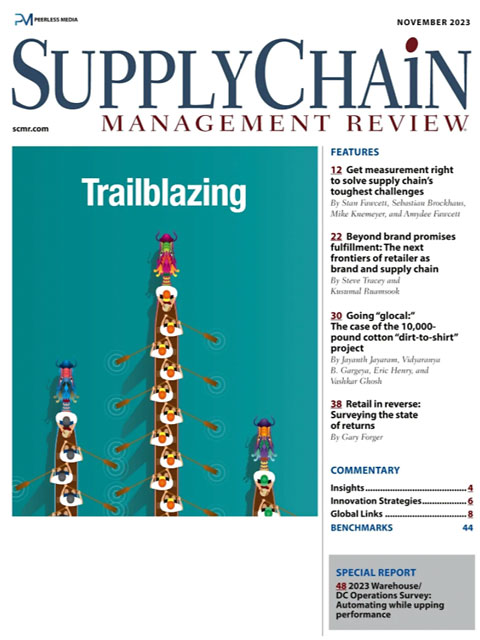Sorry, but your login has failed. Please recheck your login information and resubmit. If your subscription has expired, renew here.
November 2023
Last month, I had the pleasure of attending the NextGen Supply Chain Awards in Chicago. It was my first time attending the conference, which was in its fifth year, and I came away impressed with both the content and the quality of professionals I met in Chicago. This year’s conference—Strategies for a Digital Future—featured nearly 50 speakers and included CEOs and senior vice presidents, founders and innovators, leading academics and researchers, and top consultants. Over two days of the event at the Chicago Athletic Association, we learned more about artificial intelligence and predictive analytics, robotics and machine learning, fulfillment… Browse this issue archive.Need Help? Contact customer service 847-559-7581 More options
Some 50 million micro-retailers, also known as nanostores, serve local communities in developing economies across the globe. They are the backbone of retailing in these countries. Yet, much of their commercial potential remains untapped due to obstacles such as inefficient distribution strategies and punitive payment terms imposed on store owners.
These obstacles can be overcome if suppliers—notably large-sized consumer packaged goods (CPG) companies—and supply chain management solutions providers adopt new, more creative approaches to serving nanostore businesses. Many of the changes required are relatively straightforward and can potentially increase the profitability of micro-retail markets for all the players involved.
Logistics consequences
The customer base of a typical nanostore is approximately 100 households in the immediate area. This is a relatively small commercial footprint, but micro-retailers are hugely influential on a national or regional scale. For example, in Latin America, nanostores account for 40% to 70% of CPG companies’ sales—the most extensive channel in terms of sales volume.
Another critical characteristic of the nanostore market is its high churn rate due to the short shelf life of individual stores. A study by the MIT Low Income Firms Transformation (LIFT) Lab with a major CPG company in Mexico City found that, on average, about 10% of nanostores disappeared monthly, with roughly 11% starting up. Other studies show that the nanostore churn rate across Latin America is approximately 8%. During the COVID-19 pandemic, the rate increased to some 19%, with about two million nanostores closing.
This high level of churn directly affects the logistics of supporting micro-retailer markets. Frequent store closures and openings disrupt route plans and make it more difficult for delivery truck drivers to find accessible, secure parking spaces for unloading operations. A study by LIFT Lab researchers in Mexico City estimated the logistics costs over several months.

This complete article is available to subscribers only.
Log in now for full access or start your PLUS+ subscription for instant access.
SC
MR
Sorry, but your login has failed. Please recheck your login information and resubmit. If your subscription has expired, renew here.
November 2023
Last month, I had the pleasure of attending the NextGen Supply Chain Awards in Chicago. It was my first time attending the conference, which was in its fifth year, and I came away impressed with both the content and… Browse this issue archive. Access your online digital edition. Download a PDF file of the November 2023 issue.Some 50 million micro-retailers, also known as nanostores, serve local communities in developing economies across the globe. They are the backbone of retailing in these countries. Yet, much of their commercial potential remains untapped due to obstacles such as inefficient distribution strategies and punitive payment terms imposed on store owners.
These obstacles can be overcome if suppliers—notably large-sized consumer packaged goods (CPG) companies—and supply chain management solutions providers adopt new, more creative approaches to serving nanostore businesses. Many of the changes required are relatively straightforward and can potentially increase the profitability of micro-retail markets for all the players involved.
Logistics consequences
The customer base of a typical nanostore is approximately 100 households in the immediate area. This is a relatively small commercial footprint, but micro-retailers are hugely influential on a national or regional scale. For example, in Latin America, nanostores account for 40% to 70% of CPG companies’ sales—the most extensive channel in terms of sales volume.
Another critical characteristic of the nanostore market is its high churn rate due to the short shelf life of individual stores. A study by the MIT Low Income Firms Transformation (LIFT) Lab with a major CPG company in Mexico City found that, on average, about 10% of nanostores disappeared monthly, with roughly 11% starting up. Other studies show that the nanostore churn rate across Latin America is approximately 8%. During the COVID-19 pandemic, the rate increased to some 19%, with about two million nanostores closing.
This high level of churn directly affects the logistics of supporting micro-retailer markets. Frequent store closures and openings disrupt route plans and make it more difficult for delivery truck drivers to find accessible, secure parking spaces for unloading operations. A study by LIFT Lab researchers in Mexico City estimated the logistics costs over several months.
 SUBSCRIBERS: Click here to download PDF of the full article.
SUBSCRIBERS: Click here to download PDF of the full article.
SC
MR


Latest Supply Chain News
- Joseph Esteves named CEO of SGS Maine Pointe
- Employees, employers hold divergent views on upskilling the workforce
- April manufacturing output slides after growing in March
- Q1 sees a solid finish with positive U.S.-bound import growth, notes S&P Global Market Intelligence
- World Trade Centers offers a helping hand to create resilient, interconnected supply chains
- More News
Latest Podcast

 Explore
Explore
Business Management News
- Joseph Esteves named CEO of SGS Maine Pointe
- Employees, employers hold divergent views on upskilling the workforce
- April manufacturing output slides after growing in March
- Q1 sees a solid finish with positive U.S.-bound import growth, notes S&P Global Market Intelligence
- 6 Questions With … Sandeep Bhide
- MIT CTL offering humanitarian logistics course
- More Business Management
Latest Business Management Resources

Subscribe

Supply Chain Management Review delivers the best industry content.

Editors’ Picks






